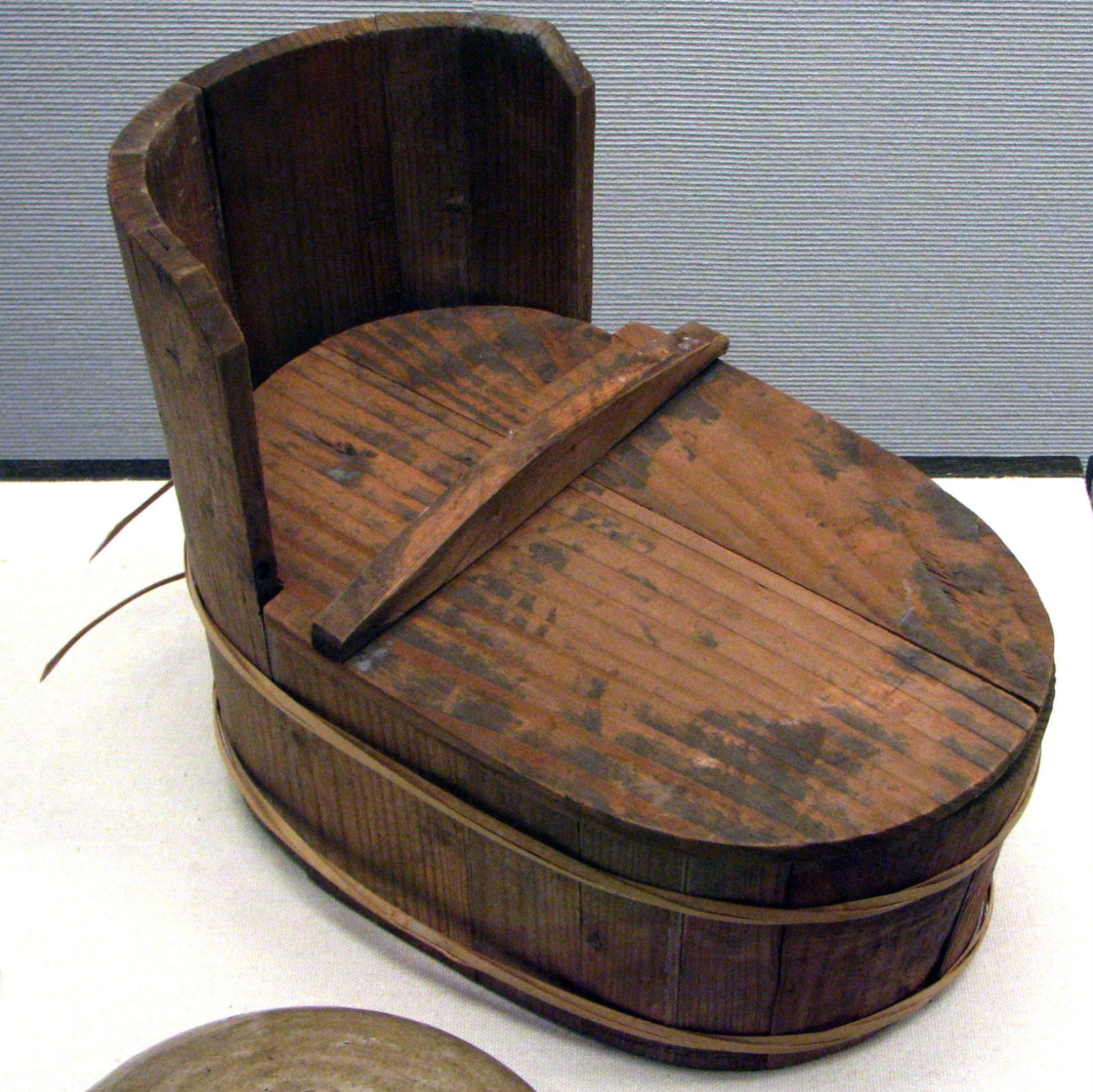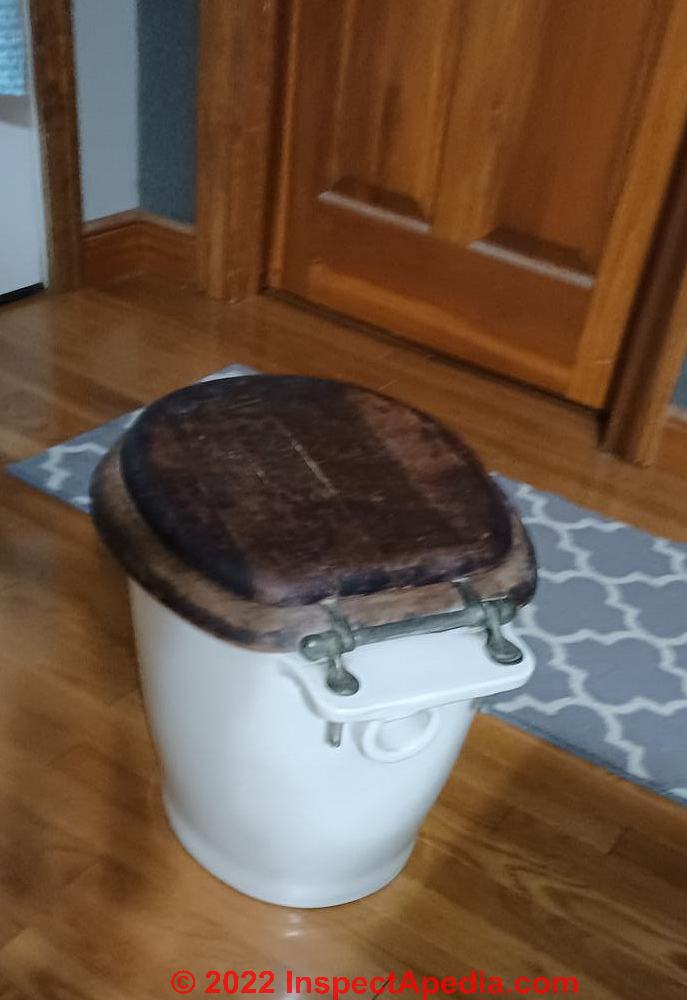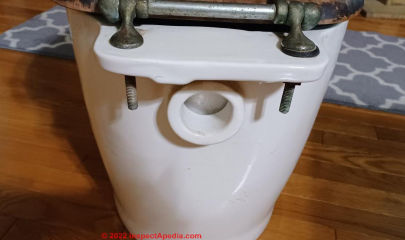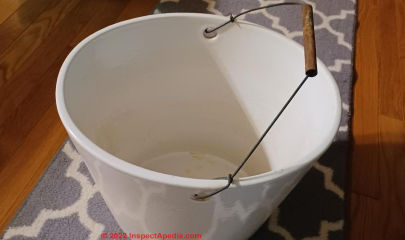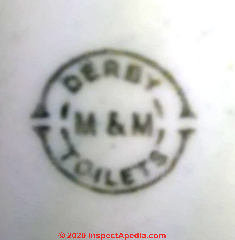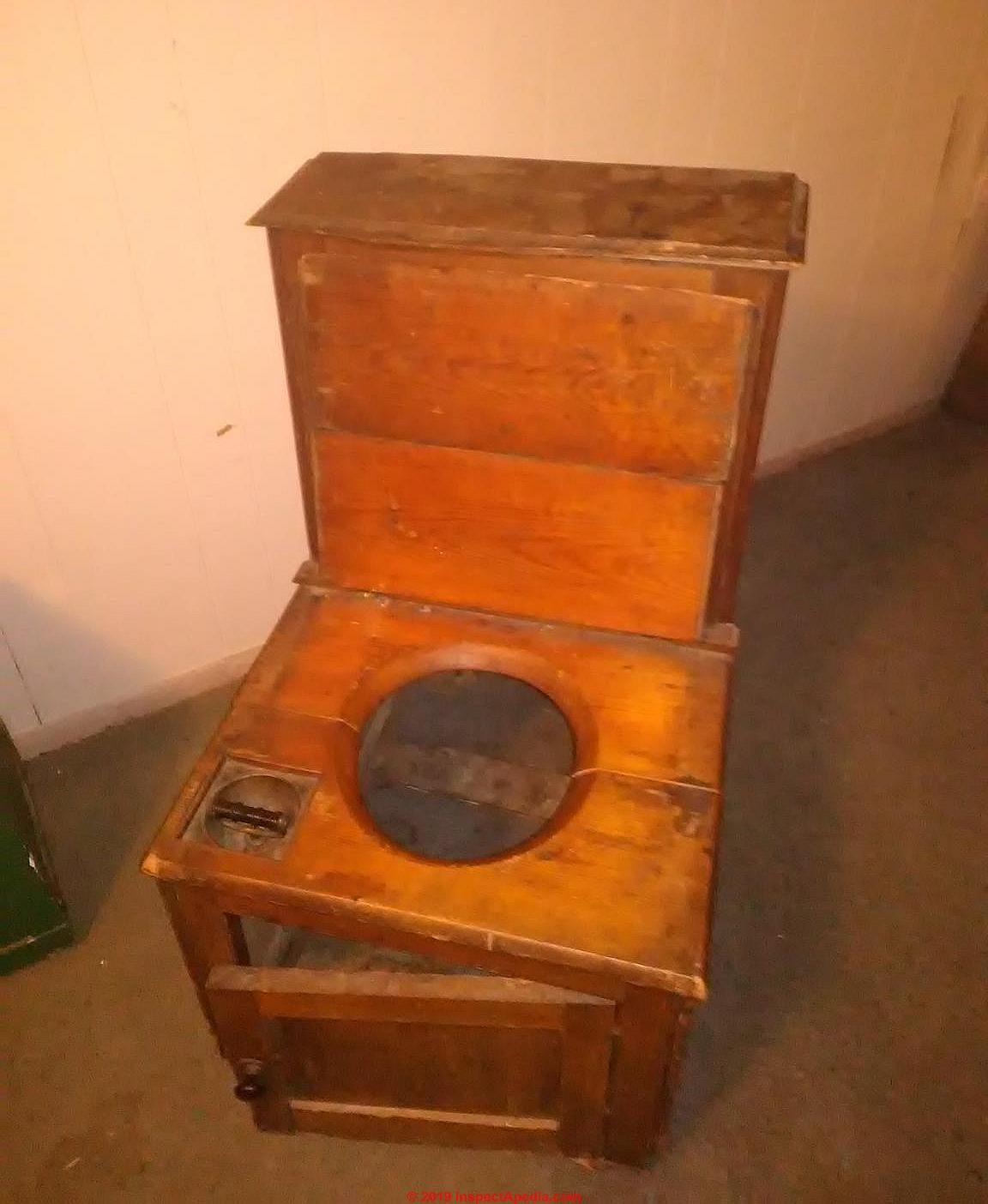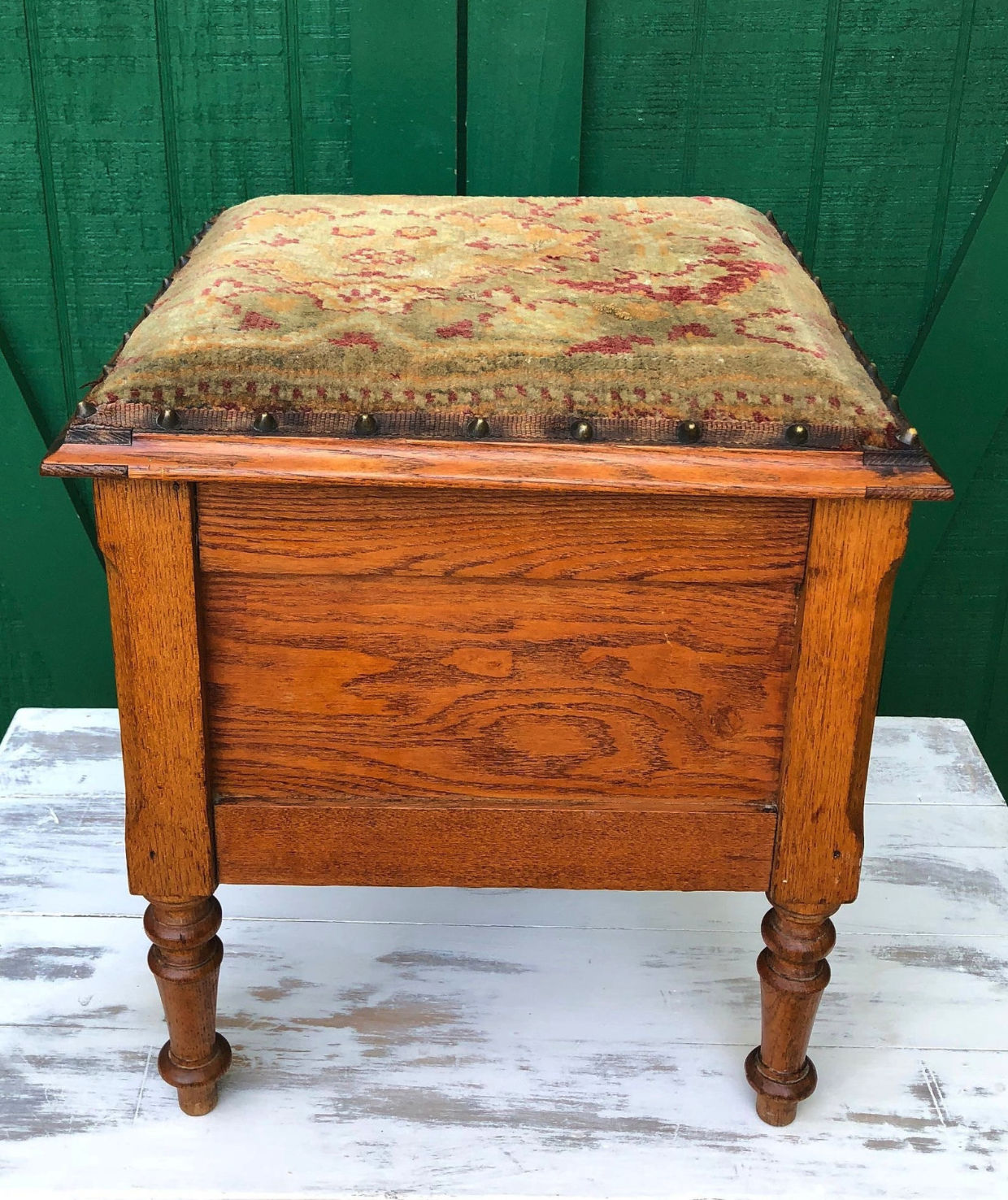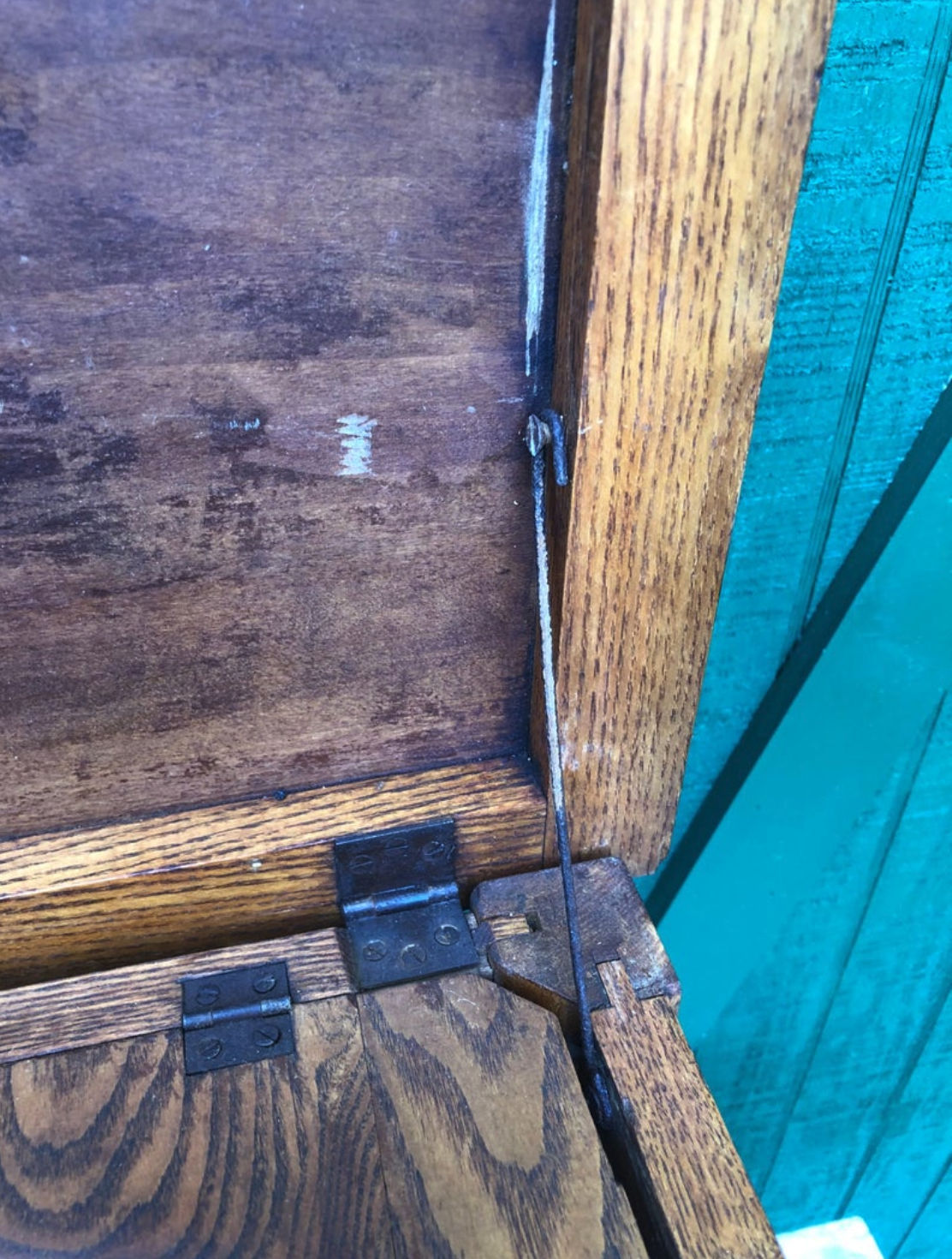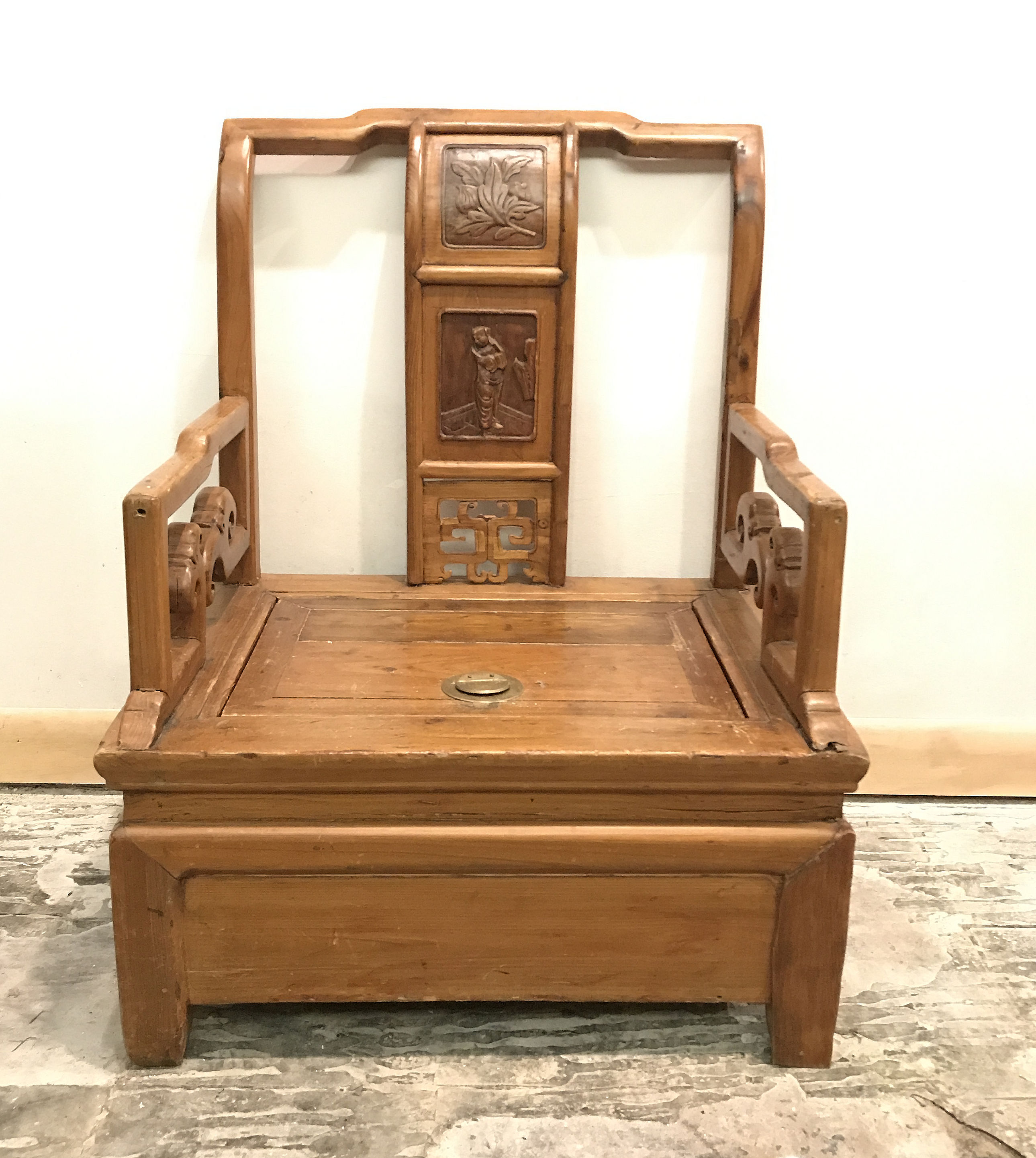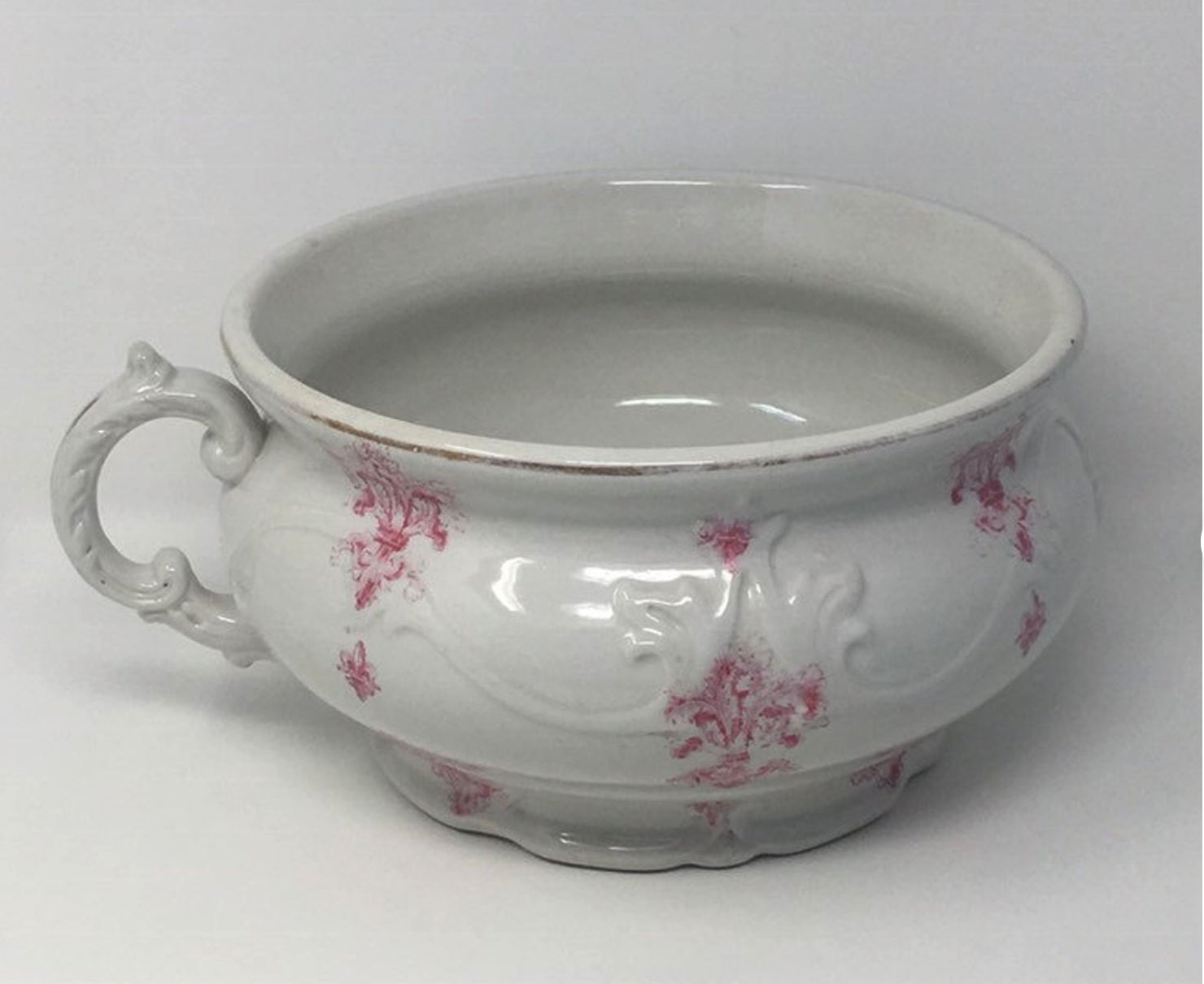 Chamber Pots
Chamber Pots
Antique toilets, close stools, commodes, garderobes
- POST a QUESTION or COMMENT about early toilet designs, use, maintenance & repair
Antique chamberpots used as indoor toilets for night soil.
This article series describes early toilets, latrines, and antique flush toilets.
InspectAPedia tolerates no conflicts of interest. We have no relationship with advertisers, products, or services discussed at this website.
- Daniel Friedman, Publisher/Editor/Author - See WHO ARE WE?
Chamber Pots, Close Stools, Commodes & Garderobes
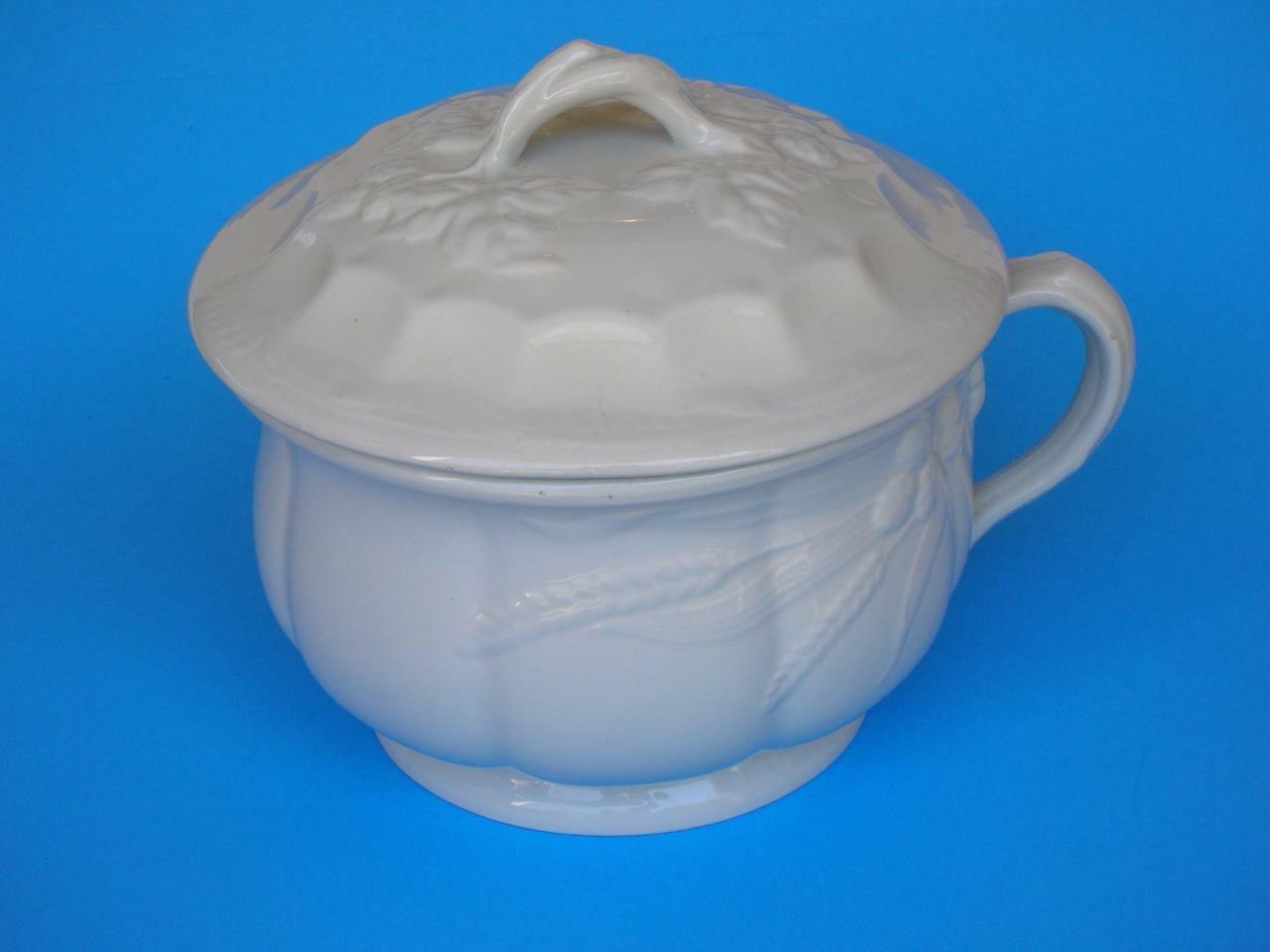 Chamber pots or containers used as a convenient, portable indoor toilet have been in use since Roman times. Here we describe typical modern-age chamber pots of various materials and we illustrate various wood or other material seats or cupboards used to make chamber pots easier to manage.
Chamber pots or containers used as a convenient, portable indoor toilet have been in use since Roman times. Here we describe typical modern-age chamber pots of various materials and we illustrate various wood or other material seats or cupboards used to make chamber pots easier to manage.
In the eighteenth century, indoor toilet needs were met in several ways. T
he two basic forms seem to have been the chamber pot, made from either ceramic or metal, and used by itself, or the close stool, a piece of furniture designed to hold a chamber pot or pan. ...
A plethora of materials and terminology for chamber pots and close stools are listed on these inventories, including close stool, close stool stand, close stool chair, night stool, and night table.
A close stool itself could take multiple forms such as an armchair with a ring seat under which was a chamber pot or a box-like piece, similar to a trunk with a lid.- (Miller et als 2001).
Above: a simple china chamber pot with lid as sold on eBay in June 2091.
Chamber pots and close stools or other constructions that held them, were a necessary part of life before indoor plumbing was common.
A close stool or garderobe (a tiny cupboard) was a construction, sometimes a simple box with forming a seat over a hole (beneath which sat the chamber pot) and a lid.
Used for night soil (defecation or urine) in simplest forms these receptacles were a simple pot with a lid, made of china, enamelware, even wood.
The porcelain chamber pot shown below was produced by Etruria Mellor & Co., and is described as a Federal style china ware vintage commode or pot.
This chamber pot was for sale at etsy.com in June 2019.
The seller noted that the large handle was intended to make the pot easier to carry without spilling or tipping. This chamber pot would originally have had a lid, now lost.
Our second photo above shows an enamelware or enameled metal chamber pot produced by the Columbian Enamelware and Stamping Company in Terre Haute Ind. The label bears a date of 1871. This pot, too, would have sported a lid.
In simplest application the user simply sat on or peed into the chamber pot, replaced the lid, and slid the pot back under the bed where it rested out of the way, not to be tripped-over, until it could be emptied during daylight hours. But chamber pots and close stools were kept in a variety of locations, in the bedroom behind curtains, in the kitchen, and in public locations as necessary.
Our wooden chamber pot photo below, courtesy of Wikipedia's entry on chamber pots in June 2019, illustrates a wooden chamber pot, in this case a Japanese chamber pot from the Edo era.
...
Reader Comments, Questions & Answers About The Article Above
Below you will find questions and answers previously posted on this page at its page bottom reader comment box.
Reader Q&A - also see RECOMMENDED ARTICLES & FAQs
Antique toilet with a removable bucket & no flush controls, no water, no connections
I have 2 of these toilets, can you tell me how they were used. They have a removable bucket inside. - Janet Schnees 2022/05/05
Moderator reply: chamber-pot toilet - garderobe?
Post another photo or two (one per comment) to show me any controls on the toilet, such as a foot pedal, other plumbing connections, &c.
Seeing the toilet's controls, interior construction, plumbing connections, and any markings or stamps or ID's or brands can help us research your question.
Reader follow-up:
Back view of the toilet - above - and a view of the bucket that fits inthe toilet - below -
Moderator reply:
What's that bucket?
I see an entry or exit port on the back of the toilet: If the toilet also has a drain then that back opening may have connected to a wall-tank for a source of flush water?
I was looking for a flush pedal or other flush control that might tell us this was used on a boat.
If there is none such, it's probably an antique toilet that was flushed by a wall-mounted tank above the bowl.
What do the inside of the toilet bowl and under-side look like? Is there a flush opening? Is there a floor mount? Or was this a free-standing fixture?
Is there really no manufacturer's name or logo?
Reader follow-up: chamber pot toilet uses an inset bucket
The bucket in the picture is inside the toilet, it is very heavy and seems to be made for the toilet, because it fits the shape very nicely.
The toilet has no holes or mechanical parts , no outlet at bottom either. It only has the one hole in the back, that's what is confusing. There are no markings on them at all.
Moderator reply: chamber pot toilet - for comfort - "Close Stool" or garderobe type alternative to a simple sit-alone chamber pot
Got it.
So this is a simple hand emptied chamber pot toilet.
Its design, presaging flush toilet bowls, allows the user to sit on a higher throne than a simple chamber-pot used alone.
I think this is a variation on the "Close Stool" or garderobe wooden apparatus for using a chamber pot that we describe below on this same page.
Most likely the back opening would have allowed it to be connected to vent to the building exterior.
What is the bucket material? Is it new or also antique?
Who made and how old is a Derby M&M Toilet?
Above is a photo of the Derby M&M Toilets Logo found on my chamber pot.
Below is the picture of the chamber pot. Marking is Derby Toilets With M & M in the middle. I am wondering where it was made and the age and value.
I am trying to identify where this marking is made. It's on a chamber pot
On 2020-11-12 by Rene Berntsen
History of Derby M&M Toilets: history of Derby Porcelain Factory in the UK - 1747 and later!
by (mod) - Rene
In the U.K. (If that is where you and your chamber pot are located), Derby Porcelain is a very old manufacturer of porcelain products, including chamber pots. The company was famous for its ornate ceramic vases and figurines as well as for plates and platters.
According to the British Museum Derby porcelain products were produced between 1748-1848.Synonyms: Royal Crown Derby Porcelain Company. (The British Museum gives many other names for the company and its principals.)
Here we excerpt from that source:
Derby Porcelain address: Nottingham Road, Derby No.8, Bedford Street, Covent Garden, London England UK
The Derby Porcelain Factory is believed to have been founded by the Huguenot, Andrew Planché in late 1747 or early 1748; another Huguenot, James Marchand may have joined him there.
In the V&A there is an unsigned partnership agreement dated 1 January 1756 between Planché, William Duesbury (who ran a porcelain decorating business in London from 1751-1753) and a banker John Heath who provided finance.Planché left around this time leaving William Duesbury (1725-1786) in charge of the Derby factory which he enlarged.
Many notable artists (incl. Zachariah Boreman, James Banford and William Billingsley) and figure modellers (incl. John Bacon RA, Pierre Stephan and Nicholas Francois Gauron from Tournai) were employed at the
Derby factory and at the Chelsea Porcelain factory which Duesbury acquired in 1770: hence Chelsea-Derby.
Duesbury also opened a London showroom in Bedford Street, Covent Garden in 1774 (first agent William Wood, then Joseph Lygo) for which there is a draft trade card in the BM. The term 'Crown Derby' resulted from the grant of a royal warrant in 1775.
Dr Johnson visited the Derby factory in 1777. Duesbury's son William Duesbury II (1763-1797) became joint manager in 1784 and he ran the factory after his father's death until with his own health failing he entered a partnership with Michael Kean in December 1795.
The 18thC Derby porcelains of particular note are the early 'dry-edge' figures; certain wares of the late 1750s and early 1760s decoratively painted with birds, cherries and moths; some of the biscuit porcelain figures of the Chelsea-Derby period and the years immediately succeeding it; and the best of the landscape and botanical painting in the closing decades of the 18thC.
Porcelain manufacture continued in the 19thC under the management of Robert Bloor (from 1715 until his health deteriorated in 1828, died 1846).
The Nottingham Road factory closed in 1848. Shortly afterwards some of the former employees set up a new factory in King Street, Derby which continued in production until 1935 when it was acquired by the owners of Royal Crown Derby which started life in a new works at Osmaston Road in 1877 and was still operating in 2000.
Two trade cards in Heal Collection (P&D): Heal,98.3 advertises "Duesbury and Co: Porcelain Manufacturers To his Majesty, Bedford Street, Covent Garden, London."; Heal,98.4 and identical card in Banks Collection (D,2.1841) advertise "Duesbury & Co: Manufacturers of Derby & Chelsea Porcelain; most respectfully beg leave to inform the Nobility, Gentry & Public in General, that they have fitted up a large & elegant suit of Rooms at No.8 Bedford Street Covent-Garden; which are now opened with a great Variety of Capital as well as Useful and Ornamental Articles.
A fine Assortment of Biscuit Groops [sic] and Single Figures; Also, A Curious Collection of Derbyshire Fluors [sic], Alabasters, Marbles, &c. N.B. The Rooms are well air'd." Trade card in Banks Collection (D,2.1892) advertises "Duesbury & Son Derby, Porcelain Manufacturers to His Majesty & His Royal Highness The Prince of Wales. N.B. The London Warehouse in Bedford Street, Covent Garden." - source: The British Museum, retrieved 2020/11/12 original source: https://www.britishmuseum.org/collection/term/BIOG68368
See also
- Bradley, Gilbert, Judith Anderson, and Robin Barkla. Derby Porcelain, 1750-1798 (Heneage) 1992. Gilbert Bradley edited a Derby Porcelain International Society Newsletter, c. 1985-95.
- Bradshaw, P., Derby Porcelain Figures 1750-1848 (London: Faber Monographs), 1990.
- Wikipedia has additional entries for Derby Porcelain as does the British Museum
M&M / Derby Porcelain made chamber pots and other ceramics, even planters;
Antique chamber pots typically sell from about $25. to $100. U.S.D.
In the U.S. there is a present M&M Ceramics company:
M&M Ceramics, 501 1ST St., Jamestown, KS, 66948-9778 USA Tel: (785) 439-6350
When was this toilet box made?
I'm trying to learn about what year this box was made On 2020-10-02 by Anonymous
Example of a modern chamber pot box / surround ?
On 2020-10-02 by (mod) - Anon:
What are the country and city of location for this chamber-pot box?
What is the dark-gray or black material at the box top?
What type of wood is the box made-of?
From your photo it looks like modern plastic or bakelite and plywood.Is that correct?
Identifying the materials of which this chamber pot surround is constructed can help us determine its age.If it's made of wood, noting the type of tool marks can also help determine its age.
See those details
at SAW & AXE CUTS, TOOL MARKS, AGEAlso see ASBESTOS in PLASTICS
What kind of indoor wooden toilet is this?
I'm looking for anything about this toilet , mmyers0013@gmail.com 2019/06/20 Michael Myers said:
Reply: "Close Stool" or garderobe wooden apparatus for using a chamber pot
Michael,
Your photo shows a wooden commode or close stool, or garderobe. If it's original and not a reproduction, it's probably from the 19th century.
Wooden commodes were built to hold a chamberpot and to provide easier use by sitting on the elevated wooden seat. Most likely, though it's not clear in your photo, there would have been a hinged top that folded down to cover the seat opening when the commode was not in use.
In simplest form a traditional chamber pot was a ceramic, metal, or even wood bowl or container with a lid used at night as a toilet - avoiding having to trek out to the outhouse in your nightdress.
Above and below are photographs of a similar commode that was for sale at etsy.com in June 2019. On that device the hinge hardware, wood joinery and stains indicate its use and probable age as late 1800's.
Without an elevated wooden seat, to urinate (or if unavoidable also to defecate) in a simple wood, metal, or ceramic chamber pot required squatting directly over the chamber pot - a position uncomfortable for some, particularly older or disabled people.
Some details about your commode would be helpful.
- What are the country and city where this was found? Do we have any information about its age?
- Is the wood pine?
- What's in the wooden back in the toilet photo? Lift the lid and snap and post a photo of the interior. Is there evidence that the back served as a water cistern?
- What's that small handle at front left on the seat? I'd like to see that in detail too.
- Inside the base are there marks or stains indicating that there was a chamber pot inserted there? That's what it looks like. A throne built to provide elevated seating above a chamber pot.
This oak commode had a seat height of about 18-inches and the top was described as 16"x16".
Below: A beautiful hand-carved Asian chamber pot "chair" better referred to as a "close stool" or "closet stool" also from the 1800's, as adapted from its illustration at chairish.com in June 2019.
- Miller, Heidi, CHAMBER POTS and CLOSE STOOLS: A Necessary Study of Colonial Private Life, [PDF] Carlyle House Docent Dispatch, Northern Virginia Regional Park Authority (Feb. 2001), retrieved 2019/067/20, original source: https://www.novaparks.com/sites/default/files/pdf/February%202001.pdf
Excerpt continued from quotes at the start of this article:
According to Peter Thorton, “usually close stools were discreetly hidden either in a niche masked by curtains, or in a specially contrived ‘stool house’ or ‘house of office’ furnished with a door.”
The recorded chamber pots were made of many different materials such as stone, earthenware, pewter, ceramic, or delft.
They were brought into the bedchamber in the evening and removed again in the morning.
By looking at the number of these items, their composition, their values, and their location on the inventory, we can get a glimpse of how they fit into eighteenth-century life.
...
...
Continue reading at ANTIQUE LATRINE GOODRICH CASTLE or select a topic from the closely-related articles below, or see the complete ARTICLE INDEX.
Or see
- AGE of a BUILDING - visual and other clues determine building or building component age
- ANTIQUE CHAMBER POTS & CLOSE STOOLS
- ANTIQUE FLUSH TOILETS
- ANTIQUE LATRINE GOODRICH CASTLE
- CONTEMPORARY TOILET DESIGNS
- LATRINE TYPES & CONSTRUCTION discusses modern latrine construction based on the U.S. Army field manual dedicated to field sanitation
- LOW COST TOILETS for a description of the McSkimming Toilet
- OUTHOUSES & LATRINES discusses traditional outhouse construction and use
- TOILET TYPES, CONTROLS, PARTS - home
Suggested citation for this web page
ANTIQUE CHAMBER POTS & CLOSE STOOLS at InspectApedia.com - online encyclopedia of building & environmental inspection, testing, diagnosis, repair, & problem prevention advice.
Or see this
INDEX to RELATED ARTICLES: ARTICLE INDEX to TOILET INFORMATION
Or use the SEARCH BOX found below to Ask a Question or Search InspectApedia
Ask a Question or Search InspectApedia
Try the search box just below, or if you prefer, post a question or comment in the Comments box below and we will respond promptly.
Search the InspectApedia website
Note: appearance of your Comment below may be delayed: if your comment contains an image, photograph, web link, or text that looks to the software as if it might be a web link, your posting will appear after it has been approved by a moderator. Apologies for the delay.
Only one image can be added per comment but you can post as many comments, and therefore images, as you like.
You will not receive a notification when a response to your question has been posted.
Please bookmark this page to make it easy for you to check back for our response.
IF above you see "Comment Form is loading comments..." then COMMENT BOX - countable.ca / bawkbox.com IS NOT WORKING.
In any case you are welcome to send an email directly to us at InspectApedia.com at editor@inspectApedia.com
We'll reply to you directly. Please help us help you by noting, in your email, the URL of the InspectApedia page where you wanted to comment.
Citations & References
In addition to any citations in the article above, a full list is available on request.
- Wikipedia, Japanese Toilets [Web page] web search 5/13/12, original source: http://en.wikipedia.org/wiki/Japanese_toilets live link updated 2025/04/29
- In addition to citations & references found in this article, see the research citations given at the end of the related articles found at our suggested
CONTINUE READING or RECOMMENDED ARTICLES.
- Carson, Dunlop & Associates Ltd., 120 Carlton Street Suite 407, Toronto ON M5A 4K2. Tel: (416) 964-9415 1-800-268-7070 Email: info@carsondunlop.com. Alan Carson is a past president of ASHI, the American Society of Home Inspectors.
Thanks to Alan Carson and Bob Dunlop, for permission for InspectAPedia to use text excerpts from The HOME REFERENCE BOOK - the Encyclopedia of Homes and to use illustrations from The ILLUSTRATED HOME .
Carson Dunlop Associates provides extensive home inspection education and report writing material. In gratitude we provide links to tsome Carson Dunlop Associates products and services.



